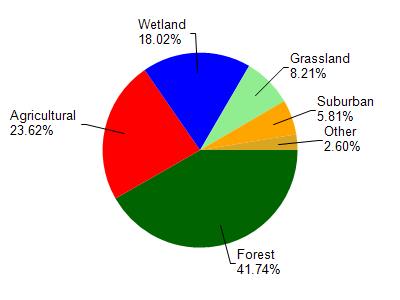Portage
No
No
No
Fish and Aquatic Life
Overview
This is a shallow soft water bog lake situated approximately nine miles northeast of Stevens Point. The muck bottom maintains a nearly uniform depth of about three feet throughout the lake. The lake is surrounded by tamarack bog except for a small area of pasture on the southeast side. There are no inlets or outlets. Water color is dark brown. No fishery is present due to annual winterkill conditions. The lake is used extensively by migrating waterfowl. A pair of loons were observed. Muskrats are also present. Portage County owns 40 acres on the north side of the lake which serves as a means of unimproved public access. Except for a town road on the northwest side the lake is basically in its natural state.
Source: 1972, Surface Water Resources of Portage County Becker Lake, T25N, ROE, Section 32, Surface Acres-31.5, S.D.F.- 1.34, Maximum Depth-4 feet
Date 1972
Author Aquatic Biologist
Condition
Wisconsin has over 84,000 miles of streams, 15,000 lakes and milllions of acres of wetlands. Assessing the condition of this vast amount of water is challenging. The state's water monitoring program uses a media-based, cross-program approach to analyze water condition. An updated monitoring strategy (2015-2020) is now available. Compliance with Clean Water Act fishable, swimmable standards are located in the Executive Summary of Water Condition in 2018. See also the 'monitoring and projects' tab.
Management Goals
Wisconsin's Water Quality Standards provide qualitative and quantitative goals for waters that are protective of Fishable, Swimmable conditions [Learn more]. Waters that do not meet water quality standards are considered impaired and restoration actions are planned and carried out until the water is once again fishable and swimmable
Management goals can include creation or implementation of a Total Maximum Daily Load analysis, a Nine Key Element Plan, or other restoration work, education and outreach and more. If specific recommendations exist for this water, they will be displayed below online.
Monitoring
Monitoring the condition of a river, stream, or lake includes gathering physical, chemical, biological, and habitat data. Comprehensive studies often gather all these parameters in great detail, while lighter assessment events will involve sampling physical, chemical and biological data such as macroinvertebrates. Aquatic macroinvertebrates and fish communities integrate watershed or catchment condition, providing great insight into overall ecosystem health. Chemical and habitat parameters tell researchers more about human induced problems including contaminated runoff, point source dischargers, or habitat issues that foster or limit the potential of aquatic communities to thrive in a given area. Wisconsin's Water Monitoring Strategy was recenty updated.
Grants and Management Projects
| Project Name (Click for Details) | Year Started |
|---|
|
|
Monitoring Projects
| WBIC | Official Waterbody Name | Station ID | Station Name | Earliest Fieldwork Date | Latest Fieldwork Date | View Station | View Data |
|---|
| 969500 | Bakers Lake | 10005135 | Bakers Lake | 8/29/2000 | 9/6/2011 | Map | Data |
|

Watershed Characteristics
Bakers Lake is located in the Plover and Little Plover Rivers watershed which is 202.19 mi². Land use in the watershed is primarily forest (41.70%), agricultural (23.60%) and a mix of wetland (18%) and other uses (16.60%). This watershed has stream miles, lake acres and 22,761.70 wetland acres.
Nonpoint Source Characteristics
This watershed is ranked Medium for runoff impacts on streams, Medium for runoff impacts on lakes and High for runoff impacts on groundwater and therefore has an overall rank of High. This value can be used in ranking the watershed or individual waterbodies for grant funding under state and county programs.However, all waters are affected by diffuse pollutant sources regardless of initial water quality. Applications for specific runoff projects under state or county grant programs may be pursued. For more information, go to surface water program grants.